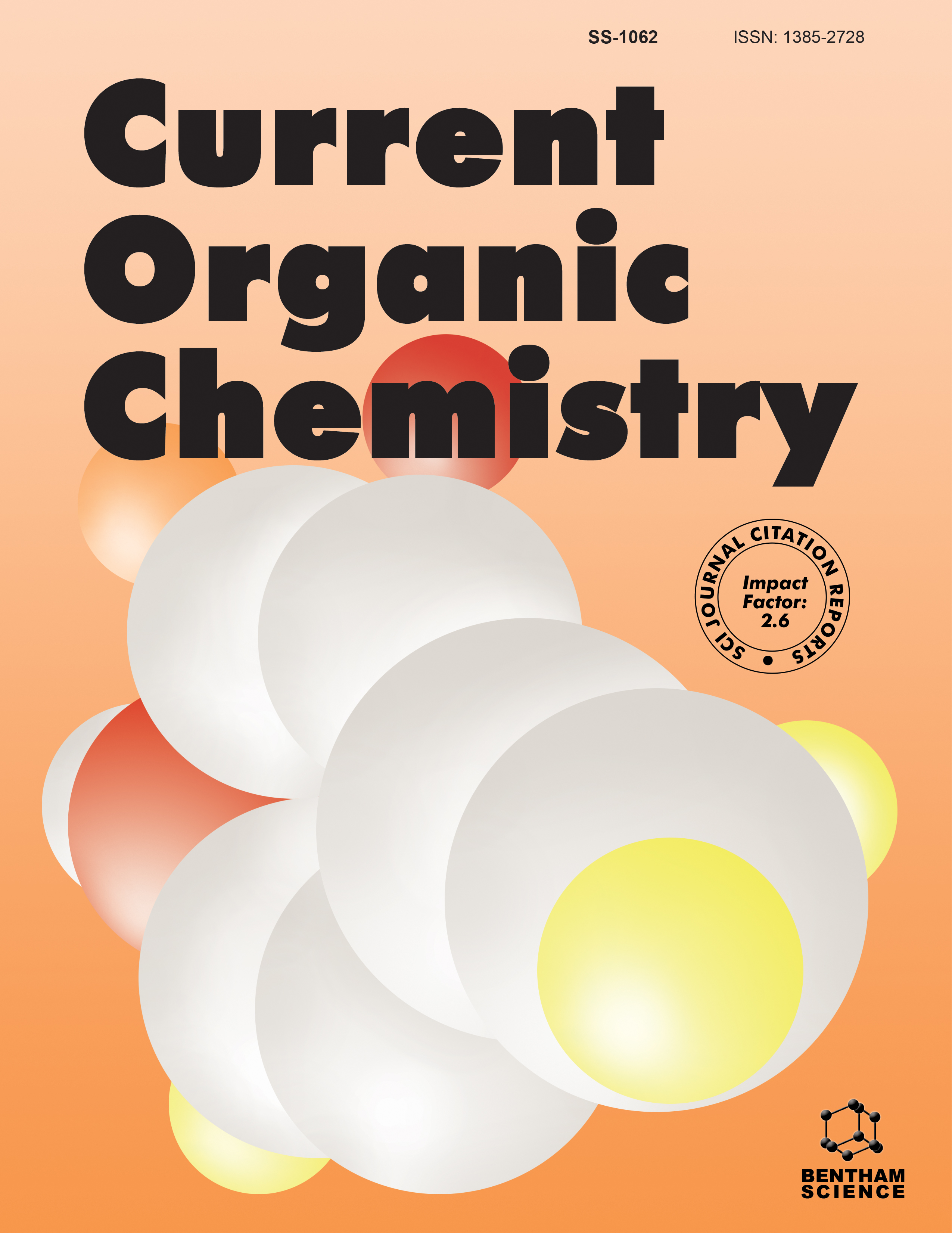- Home
- A-Z Publications
- Current Organic Chemistry
- Previous Issues
- Volume 21, Issue 24, 2017
Current Organic Chemistry - Volume 21, Issue 24, 2017
Volume 21, Issue 24, 2017
-
-
Modified Cellulose and Alumina Membranes with Organic Substrates
More LessAuthors: Maria Sanchez-Molina, Ana Lucena-Serrano, Juana Benavente and Amelia DiazIn this review modification of cellulose and alumina membranes are studied. Cellulose membranes are classified by the derivatives used for its modification. General biomedical applications of modified cellulose membranes with organic substrates are studied and their specific applications with organic substrates are also analysed. Review includes preparation of zwitterionic polymers on cellulose membranes and its biocom Read More
-
-
-
Functionalization of Mesoporous Silica Nanoparticles with Organosilanes: Experimental Evidence of the Interaction Between Organic Groups and Silica Surface
More LessAuthors: Anna D. Tedesco, Emmanuele Ambrosi, Silvia Borsacchi and Alvise BenedettiThe functionalization of mesoporous silica nanoparticles (MSNs) is a very important step in the preparation of these systems for a variety of applications. The surface of MSNs can be widely functionalized with different organic groups. There are essentially two ways to covalently modify the surface of nanoparticles: co-condensation and post-grafting. Generally, for both of these methods, the precursors are: [(R'O)3SiR] a Read More
-
-
-
Metal Nanoparticles Stabilized in Ionic Liquids for Catalytic Multiphase Reactions
More LessAuthors: Patrizia Canton, Alvise Perosa and Maurizio SelvaMetal nanoparticles (MNPs) have attracted widespread interest as catalytic materials due to their small size and high surface to volume ratio, which lead to a greater catalytic activity. To preserve such features however, agglomeration of MPNs must be prevented by the use of stabilizing agents of which ionic liquids (ILs) are probably the best ever reported compounds. ILs offer unique environments suitable for both the synthesis, th Read More
-
-
-
Increased Functionality Through Surface Grafting: Polymeric Surfaces
More LessAuthors: William J. Cloete, Bert Klumperman and Thomas E. CloeteThis chapter will give a brief outline on recent advances in grafting techniques for the surface modification of membranes made from synthetic materials or biopolymers, specifically cellulose. In addition, it highlights how these techniques may lead to polymeric surfaces with increased functionality by providing examples where various grafting techniques are used to change the nature of surfaces.
-
-
-
Supramolecular Interactions, a Route to Control Properties and Interfaces in PLA Based Materials
More LessAuthors: Marek Brzezinski and Tadeusz BielaBackground: Supramolecular interactions within polylactides chains allows for the creation of highly ordered structures with unique features that could enlarge the applications of polylactide-based materials. Method: Stereocomplexation is a supramolecular interaction which leads to the formation of complex structures from enantiomeric polylactides and interactions of L- and D-lactide unit sequences is a driving force of Read More
-
-
-
Reactions Leading to Controlled Hydrophilicity/Hydrophobicity of Surfaces
More LessThis review presents recent achievements in manufacturing of supports with controlled hydrophilicity/ hydrophobicity. The broad spectrum of reactions and polymerization processes leading to polymers tethered to surfaces is described. Commonly, brush-like polymers or copolymer layers attached to solid supports constitute the interface between the support and the surroundings. Modification of solid supports by polymer Read More
-
-
-
Modification on the Surface of Gold Nanoparticles with Imine Formation and Cycloaddition Reaction
More LessAuthors: Abdolhamid Alizadeh, Changiz Karami, Omid Marvi, Behzad Bahrami, Anita Moradi and Mohammad A. TaherBackground: In recent years, the preparation, characterization, and surface modification of nanostructured materials have become topics of great interest because of their unique properties and possible uses in technological applications. One powerful example is the embracement of “interfacial organic chemistry” by the materials science community. Objective: This study was mainly directed towards incorporating sol Read More
-
-
-
CuI-catalyzed Regioselective Sulfenylation of Indoles with Disulfides
More LessAuthors: Hanxiao Liao, Yong Yang, Wan-mei Li, Chao Shen and Pengfei ZhangBackground: While C-S bonds coupling is playing a crucial role in the syntheses of many biologically active substances, the well concerned C-H functionalization reactions have been barely employed yet in construction of such sulfur compounds. Objective: The primary objective of this study was to expand the application of copper, a cheap metal, to catalyze C-S bond construction reactions of indoles. Methods: We chose cop Read More
-
Volumes & issues
-
Volume 29 (2025)
-
Volume 28 (2024)
-
Volume 27 (2023)
-
Volume 26 (2022)
-
Volume 25 (2021)
-
Volume 24 (2020)
-
Volume 23 (2019)
-
Volume 22 (2018)
-
Volume 21 (2017)
-
Volume 20 (2016)
-
Volume 19 (2015)
-
Volume 18 (2014)
-
Volume 17 (2013)
-
Volume 16 (2012)
-
Volume 15 (2011)
-
Volume 14 (2010)
-
Volume 13 (2009)
-
Volume 12 (2008)
-
Volume 11 (2007)
-
Volume 10 (2006)
-
Volume 9 (2005)
-
Volume 8 (2004)
-
Volume 7 (2003)
-
Volume 6 (2002)
-
Volume 5 (2001)
-
Volume 4 (2000)
Most Read This Month
Article
content/journals/coc
Journal
10
5
false
en


